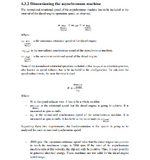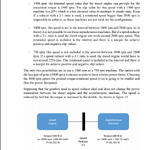Shamooooot
Electrical
- Oct 24, 2024
- 12
Hello guys
I am planning to make an AC dynamometer for research purposes to test PSA 4-cylinder diesel engines with the following specifications:
- Power max.: 60KW.
- Torque max.: 220 N.m.
- Speed max.: 4500rpm speed.
* Can't use the grid.
* Going to use dynamic torque sensor to log power, speed, and torque.
I thought of the induction motor option, but quickly changed my mind after seeing the added cost of the VFD with regenerative braking and the braking resistor.
I am now thinking of using a synchronous machine, which could indeed save me a lot of troubles, especially that I need less than 100VDC and couple of amps to control it and it would only need a load bank.. but after reading in the forum and in other places it doesn't seem to be a popular option in dyno applications. I wonder why is that and if I am missing something in such setup.
It seems to be hard to find synchronous motors that have such high speeds, and motors at that power and torque seems to be too expensive, I believe a 3600rpm rated motor can survive 4000-4500rpm. And as this won't be used as an actual generator or tied to the grid and the power would be dissipated to the load bank the job doesn't look complicated. Especially, that these motors are fairly common and could be found at a good price.
I understand that an eddy current may be the best and safest option for the job, but I am required to use an "AC dynamometer".
Thanks in advance..
I am planning to make an AC dynamometer for research purposes to test PSA 4-cylinder diesel engines with the following specifications:
- Power max.: 60KW.
- Torque max.: 220 N.m.
- Speed max.: 4500rpm speed.
* Can't use the grid.
* Going to use dynamic torque sensor to log power, speed, and torque.
I thought of the induction motor option, but quickly changed my mind after seeing the added cost of the VFD with regenerative braking and the braking resistor.
I am now thinking of using a synchronous machine, which could indeed save me a lot of troubles, especially that I need less than 100VDC and couple of amps to control it and it would only need a load bank.. but after reading in the forum and in other places it doesn't seem to be a popular option in dyno applications. I wonder why is that and if I am missing something in such setup.
It seems to be hard to find synchronous motors that have such high speeds, and motors at that power and torque seems to be too expensive, I believe a 3600rpm rated motor can survive 4000-4500rpm. And as this won't be used as an actual generator or tied to the grid and the power would be dissipated to the load bank the job doesn't look complicated. Especially, that these motors are fairly common and could be found at a good price.
I understand that an eddy current may be the best and safest option for the job, but I am required to use an "AC dynamometer".
Thanks in advance..


